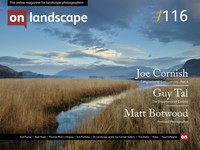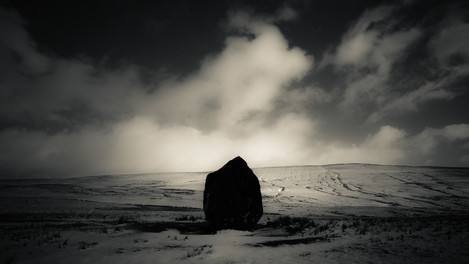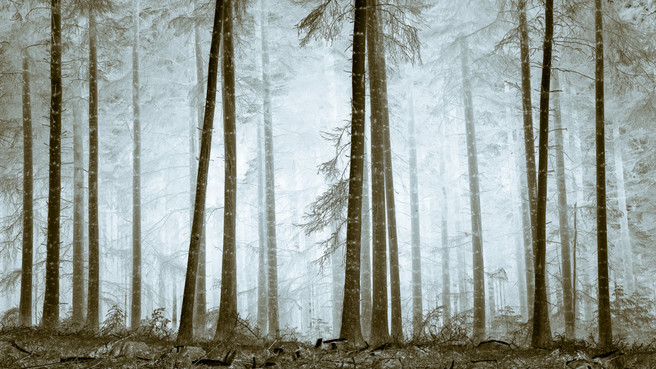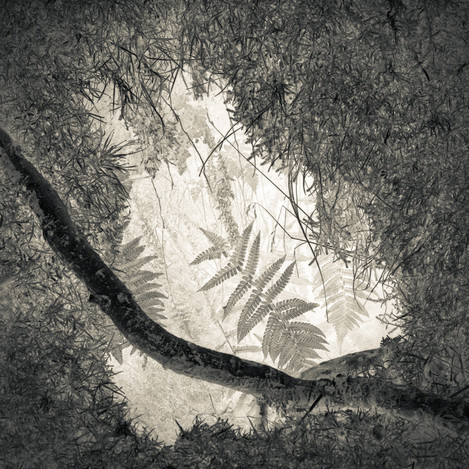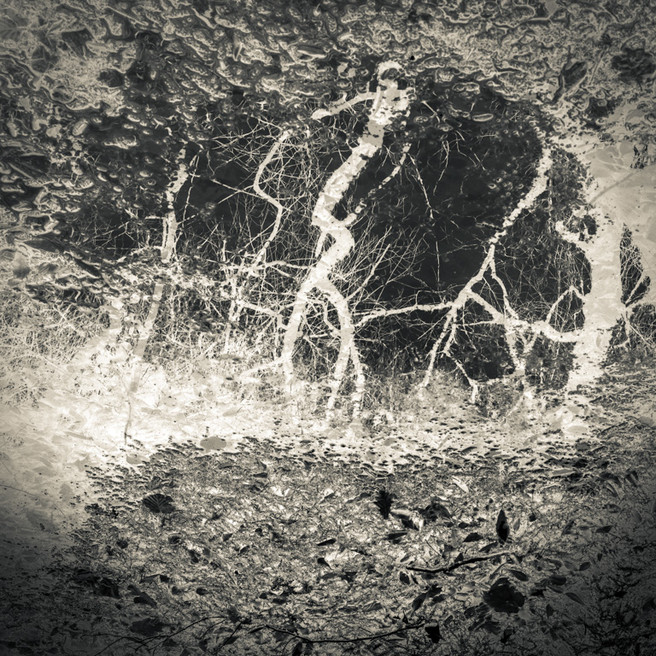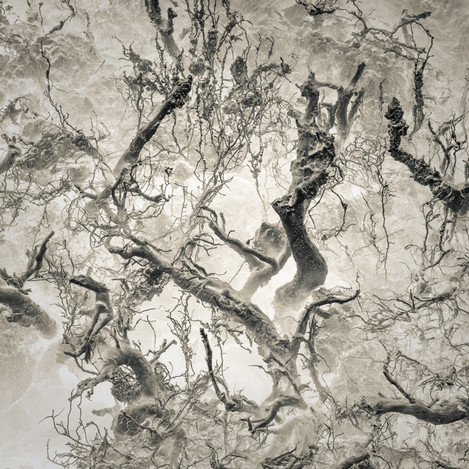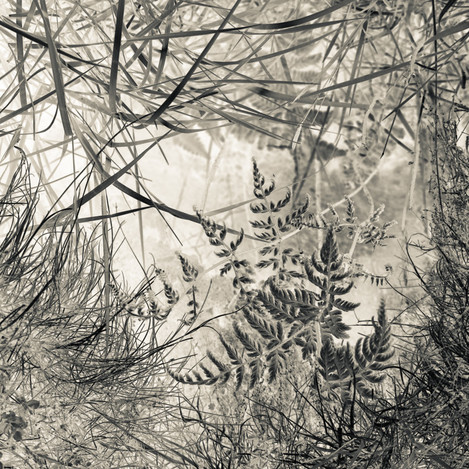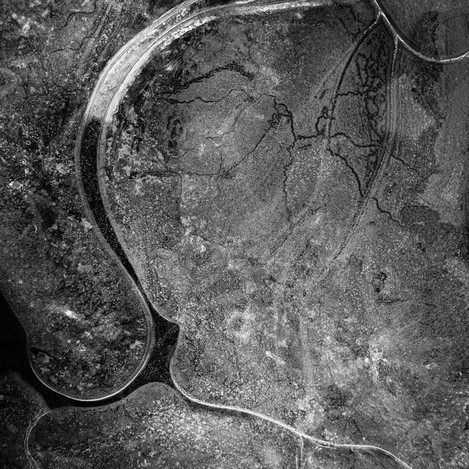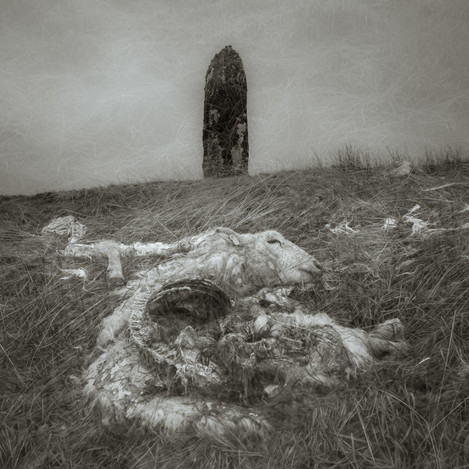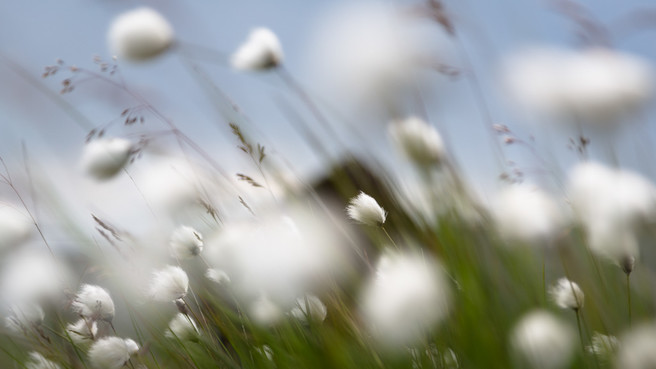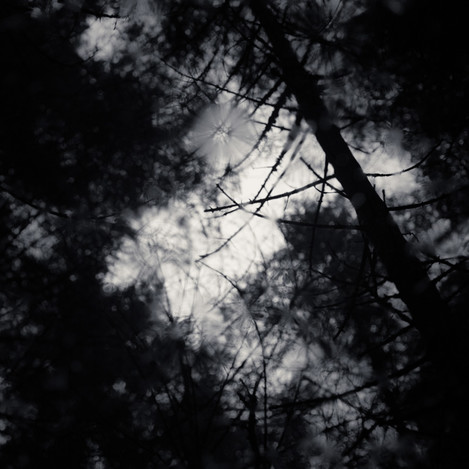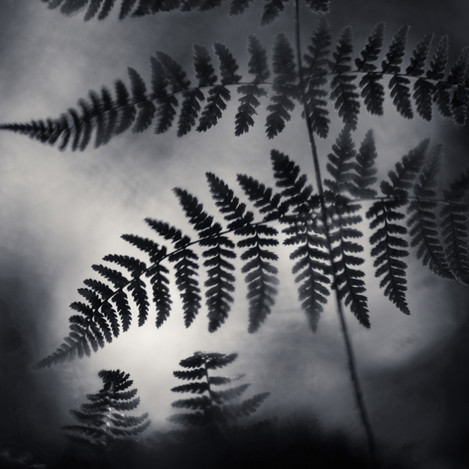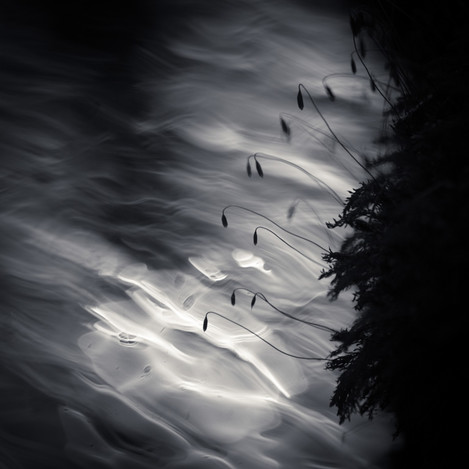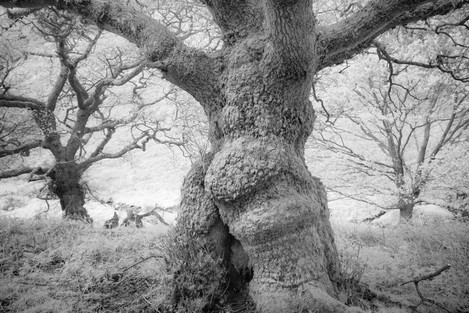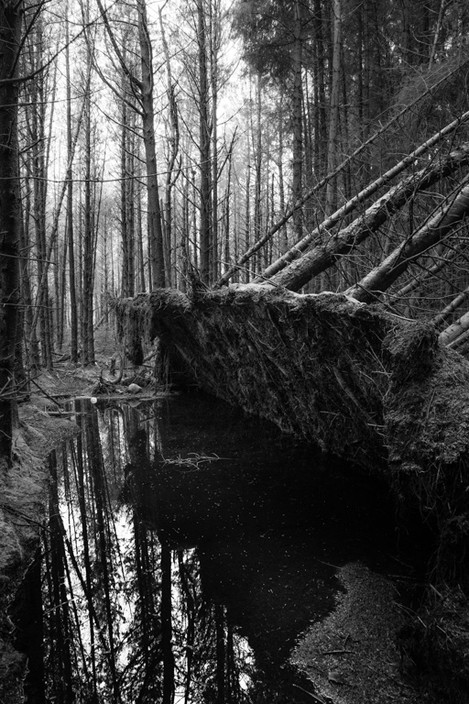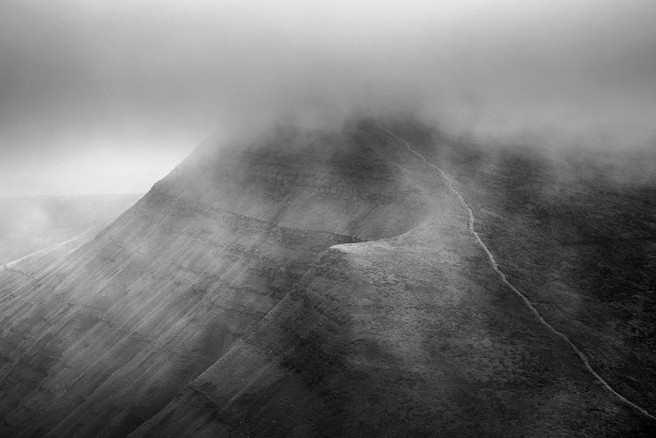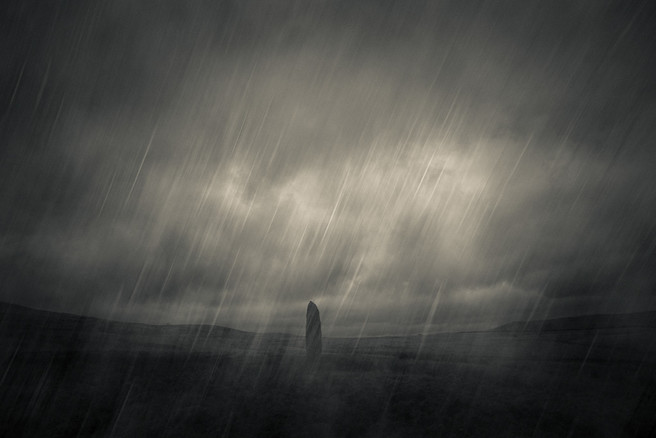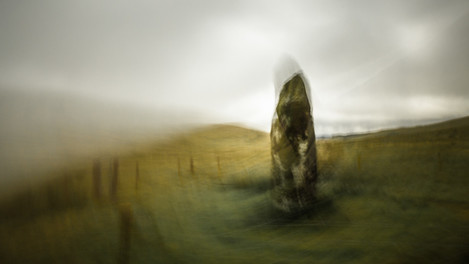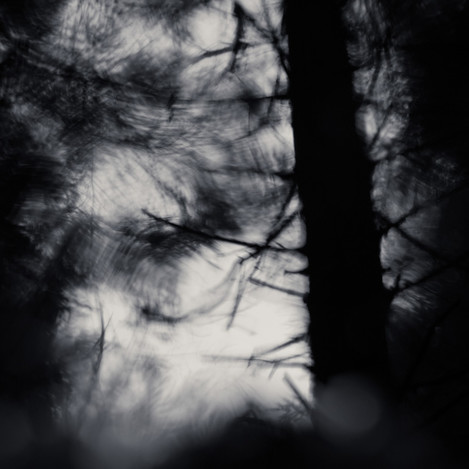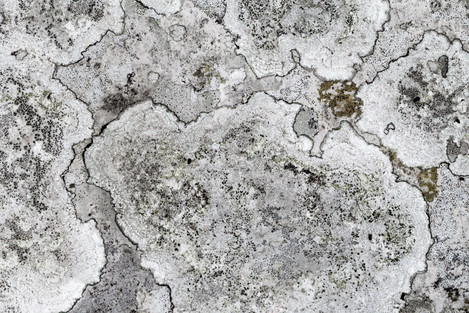Featured Photographer

Matt Botwood
Matt Botwood is a landscape photographer based in the Brecon Beacons who takes a predominantly project-based approach to photography. Taking time to explore subjects in depth over an extended period, using a variety of creative aproaches and tending to gravitate towards monochrome.

Michéla Griffith
In 2012 I paused by my local river and everything changed. I’ve moved away from what many expect photographs to be: my images deconstruct the literal and reimagine the subjective, reflecting the curiosity that water has inspired in my practice. Water has been my conduit: it has sharpened my vision, given me permission to experiment and continues to introduce me to new ways of seeing.
Twitter led me to Matt, and to his book “Travels in a Strange Land: Dark Spaces”. I knew that he worked predominantly in monochrome, so when I came to do the prep for this interview, I was a little surprised to see that his website opens with colour images. But if you meander beyond the Galleries you’ll find the Project work that increasingly occupies him these days. It’s a journey many of us are on, through the learning curve of the view and deeper within – looking more closely at details in our local patch, and blurring the lines a little between landscape and person.
Can you tell me a little about your background – your education, early interests and career?
Despite being very proud of my association with Welsh landscape photography, and living in Wales since 2000, I’m originally from Hertfordshire in the home counties of England. I’ve always loved the outdoors and walking in the hills, so to move to the Brecon Beacons and live 1000ft up the hillside in a remote farmhouse is perfect.
I always wanted to be a photographer when I was at school, but as I was also very good at science, I ended up focussing on this and studied Biochemistry in London and then carried on to a post-graduate degree at Oxford. I was on an obvious track for a lifelong career as a scientist until I realised that research wasn’t anywhere near as exciting as I imagined and suffered from the same petty politics that any job does. After a brief stint in medical publishing, I ended up being invited to join a small IT start-up company that specialised in drug discovery software, a very new field at the time and something I’d had experience of while working at Glaxo as part of my first degree. Being at the start of something completely new is very exciting and offers huge mental challenges as you have to learn everything very quickly with no outside training.
After the birth of my first son in 2004, I had an opportunity to give up my career and become a househusband while my wife went back to work. By this point, the company I was working for had grown dramatically in size and lost much of its start-up appeal so it was an easy decision. However, the thought of giving up a career that has consumed most of your waking hours for many years is quite scary, and so I had to have something else to focus on that I could fit around my childcare duties. As I’d always wanted to be a photographer, loved the landscape and now lived in the ideal place for landscape photography it seemed like a perfect opportunity, and a good excuse to buy one of those new-fangled DSLRs.
I learned pretty quickly that producing saleable landscape images wasn’t too tricky, and there were plenty of other opportunities for a photographer to make money in terms of stock photography and portrait work, but that by focussing primarily on selling images and photography services I had less and less time to go out in the landscape and take photographs. Hence I’ve now scaled back on the commercial side of my work; I no longer do family portrait work (previously one of the most lucrative strands of my photography), and I rarely upload new images to photo libraries, but I do still sell landscape prints commercially from my website and a number of small galleries and other outlets around the Brecon Beacons.
I realise that I am extremely lucky to be in a position where my photography doesn’t have to maintain my lifestyle (or maybe I made the right career choices after all!), but I’m determined that it has to pay for itself. No new piece of photographic equipment or book is produced without it being able to recoup the costs in a sensible timeframe, so I will always carry on producing commercially viable images.
How and when did your relationship with the camera start? What kind of images did you initially set out to make?
I dabbled with darkroom multiple exposures and tried loads of Cokin filters (the height of the 1980s “creative” photography), but the majority of my images were just snapshots. Vernacular photography has become very popular and looking back at the few images that I still have from those days it’s easy to see the appeal of accidental art produced in this way. One of the images I have from back then bears a striking resemblance to some of my more recent work, although completely unrepeatable. I was clearly interested in more abstract images even back then.
After leaving school, my photography was mainly limited to holiday snaps, although I did do some photography for the University student magazine at one point. When I started to work my desire to travel and explore (rather than just sit by a pool in the sun) meant that my holidays were slightly more adventurous than most and my (now) wife and I spent quite a few years visiting the Middle East. Places that you’d be very unlikely to visit these days such as Syria, the Bekaa Valley in Lebanon and the Sinai Peninsular in Egypt. The images from these trips are fascinating to look back on about the recent history of the region, but more documentary than anything else and certainly with very little creative input.
Although you are self-taught, you chose to go and study photography later on. Did this bring about any changes in you as a photographer?
Before this it was very much the case of simply do I think this is a good picture or a bad picture (whatever that means), but now I had a project brief it was more whether or not the image said what I set out to achieve and how it fitted with the rest of the images in the project. There was a lot of research, reading and writing, encouraged at college and while this probably put most of the others off the course it was something that was important for me to progress in photography.
Can creativity be taught?
Personally, I don’t think it can be. However, I’m convinced that most people have the ability to be creative in some way; it’s just unlocking that potential. Art-based education should be focused more on nurturing existing creativity and encouraging personal expression. This is the real key to me; art is all about personal expression not just regurgitating a set formula to produce something that people will like. I think this is a path that many photographers follow early on in their journey.
It’s perhaps too easy to think of photography as an exercise in learning techniques and buying new technology to produce what are perceived as “better” images, and this is certainly the impression you get from a lot of the glossy photography magazines. While these images may be technically more perfect, it doesn’t make them more creative or artistic, and I would argue that sometimes imperfection is an important part of the final image and communicating what you are trying to say. However, some people get a lot of enjoyment out of taking this technology & techniques approach to their photography and as a former scientist, I can see the appeal that this has.
Who (photographers, artists or individuals) or what has most inspired you, or driven you forward in your development as a photographer?
I always find this hard to pin down. Like most people when I was new to photography I aspired to produce stylistic copies of other photographer’s work that I admired, and I think there is nothing wrong with this as a starting point, but for some time now I have tried not to get too close to other landscape photographers’ work as I am always fearful that inspiration will turn into emulation. I do buy a lot of photography books and would count photographers such as Bill Brandt, Martin Parr, Joseph Hoflehner and Edward Burtynsky as some of my favourites, but how this has influenced my work I’m not sure.
There are of course people in the photography world whose approach to their work I find incredibly inspiring, especially those who are single-minded enough to pursue very long-term projects. Mike Jackson, Iain Sarjeant and Chris Tancock are just a few of the artists who I admire and drive me onwards to focus on my projects. I am also greatly inspired by street photography (both historical and contemporary) because I think it is one genre where a single image can tell a whole story and also because having tried it myself I realise how hard it is to capture these moments and I greatly admire those who can do so.
Looking at my images you might not be surprised that I am a great fan of pictorialism, and I enjoy a lot of images from this period of photography’s history. The development of software like Photoshop and Instagram has given this style of the image a bit of a bad name in contemporary photography as people often just assume you are applying a pre-defined filter to your images. This is not how I work, but the whole ethos of images not having to be in sharp focus, having more textural elements and the idea that images are being “created” rather than simply “recorded” appeals to me a lot.
As a teenager, I was fascinated with the surreal works of Dali, the abstract blurriness of Francis Bacon and the optical illusions of M. C. Escher and I think there are elements of some of these in my more recent work. However, primarily I like to think that my inspiration comes from the natural world around me. It can often start with something very trivial or insignificant such as wondering why a specific part of the landscape looks as it does, but then progress through research and understanding to my desire to tell the story as I see it through my images.
I was interested to hear you talking about the distinction between photography that comes about through a love of the countryside and living in it, and that which is the result of people visiting an area – on their own, or in a workshop? They may still love the land, but the relationship differs?
This is mainly an issue of familiarity and having enough time to be able to do more than just “scratch the surface” of a place. Whenever I visit new parts of the countryside or travel abroad to new countries, I find myself just taking broad landscape images or superficial details. I am just recording what is there as I haven’t had time to absorb and react to my surroundings in the same way as I have been able to by living in the Brecon Beacons for many years. I can still appreciate a new place when I visit it for the first time, and there is definitely a thrill about seeing an incredible new landscape, such as Iceland. Personally, I don’t feel I know a place well enough to create more meaningful photographs until I have been there several times or over an extended period.
Looking through your images, there’s a sense that you’ve found yourself photographically in recent years. How much has your vision changed and what have you learnt in the process?
I’m not sure if my vision has changed hugely over that time, but what I have done is learn how to translate my vision into a finished image. In the past, I have been frustrated with my ability to produce the type of image I had in my mind, but I guess that comes with experience.
Over the years, I have also learnt to show the work that most interests me and worry less about the influence and opinion of others. Initially, this meant that those who were following my photography lost interest in the new work I was producing, but I soon found that there were other people out there who did enjoy it. I think there is an audience for all types of images; you just need to find like-minded people who will appreciate it although the danger then is becoming tied to pleasing your new “followers”. You have to be prepared to move on and produce whatever work you feel you need to progress artistically without worrying about how it will be perceived by your current audience.
I gather you were a little surprised with your Landscape Photographer of the Year commendations in 2014, and while you said that you didn’t think the images would ‘fit’, you felt that you ought to enter them?
The Take-A-View LPOTY competition is one I have entered every year since its inception in 2008 when my photography was much more focussed on a commercial style of landscape photography, and I have had a fair few images shortlisted over the years. As my style has veered away from what most people would think of as traditional landscape imagery, I have had lower expectations of my images being selected and tended to enter mainly those that I thought would appeal to the judges.
But I also felt that I should be true to myself and enter a small selection of images that accurately represented my current photographic style, although I never expected these to be the ones shortlisted and then commended and that’s why I was surprised.
The overall winner in 2014, Mark Littlejohn’s excellent “A Beginning and an End”, is probably my favourite LPOTY winner of all time and I think demonstrates that the judges that year was more open to abstract and creative approaches to landscape photography. There is, of course, an element of luck in a lot of these competitions, and maybe 2014 was just my lucky year.
Travels in a Strange Land might at first seem to be a bit of a creative leap, but I guess that it came out of other work? As you follow one line of enquiry, others often open up and we learn to see things that previously we did not fully perceive.
That’s exactly what happened in this case. If I look back at my projects over the last few years, I can see the point where one led to the next, or at least fed in some important thoughts. There is a direct progression from my Into the Darkness series through most of the projects that followed right up to my current Ephemeral Pools series; the locations, the approach to capture, the processing and style have all developed throughout these projects. Some of the links are obvious, even to the outside viewer, but there are also unpublished asides to some of the series which led me to a new place. That is one thing I love so much about photography; it is one long creative journey, and I am constantly surprised at where it can lead.
In a sense with this, you’re celebrating the tatty bits, the detritus that so many photographers would leave out of their images?
Which is odd really, because I always think of myself as someone who likes nice tidy compositions and often minimal images. But you’re right; a lot of my recent work has been made in locations that many people would walk past without a second glance, and a wider view of these locations would be very uninspiring. A lot of this comes out of increasing familiarity with a location. Once you have exhausted the obvious “pretty” parts of the landscape, you start to look much closer and realise that beauty can be found in all sorts of places. I don’t think I go out of my way to photograph these tatty bits; it’s just turned out that there are a lot of interesting things to be found there and looking more closely at the details has allowed me to create more abstract and interesting images.
From the Edge of Darkness used negative images too. Are you quite interested in vision and perception, and how our brains both play tricks and can themselves be fooled?
I like images that make you look twice and take a bit of effort on behalf of the viewer to work out what is going on. With my use of negatives in Travels in a Strange Land : Dark Spaces I realised that they did not always look like negatives, as the brain doesn’t expect to see images inverted and the close composition meant that reference points that would give the image away were mostly not present. I was interested to apply this to a broader landscape view to see if it was still the case. I found that under certain lighting conditions and with the right composition it was often hard to tell whether the image was negative or not. I mentioned before that I like the images of M. C. Escher, and I think that optical illusions appeal to the scientist in me. The human brain is an amazing thing, but it is surprising how simply it can be fooled.
Maen Lia I believe was shot over the course of a calendar year and for this you mixed colour with monochrome? Straight(ish) views with ICM and layers?
My Maen Llia project came about mainly because I was frustrated with the images I already had of this standing stone. It is just down the road from my house, and I’ve visited it a lot over the years to take images for commercial use, but I never really felt that I had an image in my library which truly represented the stone in the way I see it in my mind. I mentioned this to fellow Welsh photographer Rob Hudson, and he suggested that it would be a good subject to study for a year, and as I had already considered this in the past, I thought it might be the best way to explore the subject in enough depth to solve the problem.
I initially set out with a very open mind, trying all sorts of techniques, but quite quickly settled on a few approaches that I thought best combined the stone with its surroundings and the prevailing weather at the time. The most successful images for me are the multiple exposures (some also using ICM) that I used to reinforce the feeling of the weather during my visits. It’s a bleak location with very few other points of interest, and I set out to use only what I found at the site at the times of my visit to produce in-camera multiple exposures. I tend not to use much colour in my personal work, but I felt that there were some days and weather conditions where the only colour could convey the right feeling. I processed well over 400 images during the year and published a subset of these on social media and my website during the year, but beyond producing a video slideshow of a selection of them I haven’t finalised the core images that make up the project in my mind yet. I am however very happy with quite a few images from the year and feel that I now have several that capture the megalith successfully, which was, of course, the primary goal.
There’s quite a contrast between Maen Lia and Ephemeral Pools – from permanence to the transient?
They are very different projects and aim to communicate completely different things about the landscape. Maen Llia is all about the solid subject matter of the rock and its surroundings; it is very much about the physical world. It was also a project with a defined finish point and quite limited goals. Ephemeral Pools is an impression of the landscape and perhaps more about me than the subject matter being photographed.
What both of the projects do have in common is their locality. Both places are very close to my home, and I find myself spending more time working locally as time goes on.
For Ephemeral Pools, you’re playing around with focus / defocus and image distortion? Is this purely for creative effect or are you trying to say something about impermanence, about life?
It is in part about the transient nature of the landscape, and the approach I have used was chosen specifically to enhance this experience. All of the images are shot at the same wide f2.8 aperture so that only a small portion of the scene is actually in focus, and because of the nature of the subject I am photographing sometimes this focal point is blurred by the movement of water or the wind moving the reflected trees. Of course, these things all affect the larger landscape too, but it is much more significant at this level and by using the locations and approach that I have chosen I have sought to emphasise this.
More recently this series has started to develop into my version of Stieglitz “Equivalents”. It is becoming much less about the subject being photographed and more about my thoughts, experience and emotions. Of course, the images are affected by the prevailing conditions when I visit, and wind and rain play a huge part in the final result, but the images I create on a particular day are always a reflection of my own state-of-mind that day.
You’ve also been experimenting with animation and video, and using music?
I started to explore these alternative methods of recording the scene when I realised that in some cases it was impossible to capture what I was experiencing in a still frame. Initially, I tried to illustrate the movement by shooting sequences and presenting them as triptychs, and then I realised that I could use the same images to created animated GIFs. This was just the start of experimenting with different ways to represent the scene in front of me, and video was an obvious next step. I haven’t shot much video at all in the past; with the exception of a few test shots, this is the first time I’ve really used the video function on my DSLR. I had to explore a whole new set of menus I didn’t even know existed!
Video needs sound to work well and at first I just assumed that I would be able to use ambient sound from the forest, but even with a decent microphone, I found that there just wasn’t much available to record in the forestry plantation most of the time. Music was the obvious solution, and I did some searching for usable soundtracks with varying success, but ultimately with someone else’s music you’re just shoehorning it into place, and there is no real meaning attached to the selection. The solution came through a discussion with a good friend, Zillah Myers, who is a fantastic piano player and very interested in composition; she was keen to get involved with the project. By the time Zillah was ready to start composing music, I had amassed quite a collection of video clips, and I decided to let her have everything so that she could choose which clips to compose for. In this sense, it was a real collaboration, while I shot the original footage she ultimately selected those that she wanted to compose for and then I let her have the final say on the way it was all put together. Producing any art can sometimes feel a little selfish, with no external input from anyone else, so it was a great experience to work so closely with another artist and have feedback on my work from someone with a vested interest in the result.
I know that you are reluctant to pre-plan photographic outings and have said that it (pre-planning) limits photographic development? You’ve also said that you need to be on your own to make an image that you are happy with?
Maybe I was a bit flippant, and that’s perhaps a bit extreme, of course, I do my fair share of planning in terms of the locations I visit, but what I mean is that I don’t go out planning to get a specific image. That approach only tends to lead to disappointment in my experience, and I do believe that it can stifle creativity as you become too focused on a single objective.
Part of the creative side of photography for me is having time and space to think about my surroundings and reacting to them while I am on location, and having other people present also detracts from this. It’s not that I can’t make an image, just that I can’t make an image that means that much to me. If I was out in the mountains shooting what I would call “straight landscapes” I don’t think this would matter so much, but for most of my project work the images are so influenced by my thoughts and feelings at the time it would be difficult to achieve the same images with an audience. The exception to this has been the occasions when I take my children with me as I find it much easier to actively engage them in the image creation process. Perhaps it is because children are naturally creative, willing to do silly things and less self-conscious. I have created images for a few of my recent projects with key participation from one or other of my sons to make an image that wouldn’t have been possible without them present. When I look back at these images I can see their input, and I find this very satisfying.
Which cameras and lenses do you like to use and how do they affect your photography?
I should say from the outset that I have very little interest in the minutiae of photography equipment that seems to pervade many discussions among photographers, although I understand the appeal of new technology and of course the camera is an important tool for me.
The most important thing to me is familiarity with a camera; so that I don’t have to think about how I’m using it. Hence, I’m not one for switching brands for an intangible technological gain every few years and have used Canon cameras since the early 1990s - I like the handling and have never had any problems with image quality. Due to the dreaded sensor dust and my desire to never clean it (I’ve had bad experiences in the past!) I hate changing lenses out in the field unless absolutely necessary so I am a great fan of zoom lenses and also love using wide apertures, so my mainstays are a 24-70mm f2.8 and 70-200mm f2.8. But I still have every lens I’ve ever bought and some of these also get an outing if I need something wider or for macro work.
I’ve only bought 4 DSLR camera bodies in my life, and I still use 3 of them. I had my original Canon 5D converted for infrared capture many years ago, which I tend to use sporadically when it suits a specific project (like my Dancing Trees series), but mainly I use a Canon 6D for its smaller size, high ISO performance and GPS tagging functionality. I use my 5D MkIII (which surprisingly survived an underwater excursion in Llangorse Lake back in 2014) whenever I want to capture multiple exposures as it is far superior in this respect to the 6D.
I’m sure I could use almost any camera to achieve what I do and could work within its limitations. Some people like to define themselves in part by the camera they use; I prefer people to focus on my images.
How much do you set out to achieve in camera, and what do you aim to achieve through post-processing? You’re not precious about how many images you shoot – you don’t subscribe to the school of ‘if I limit myself they will be better’ – so workflow must be important.
Although I aim to get as much right in camera as possible, primarily to save time later on, I don’t really worry about differentiating where I do something. Sometimes it’s just much easier to tweak a composition or the exposure on a large screen back home than it is crawling around on the forest floor or up in the mountains in a blizzard. A lot of my project images are square format and split-toned monochrome so clearly much of my processing cannot be achieved in-camera, and as I tend to expose as far to the right as possible most of my images have to be darkened significantly in post-processing. I am also a fan of adding grain as the perfectly smooth capture of today’s digital cameras at low ISOs is not really to my liking. As I mentioned before all of my multiple exposures are created in-camera and I like this way of working in the field rather than using layers in Photoshop. Almost all of my post-processing is done in Lightroom which I find to be an excellent tool and it has replaced numerous bits of software that I used to use for RAW management and cataloguing as well as processing in the past. If I have to resort to Photoshop these days I usually feel like I’m cheating, but of course these are just made-up rules that I follow myself and other people have different ways of working which are equally valid.
Although I’m happy to shoot a lot of frames while out on location to make sure I haven’t missed something I’m quite ruthless about deleting them (both in the field and back at the computer) and only keep a small proportion of images, most of which are fully processed and catalogued. I don’t tend to keep a backlog of unprocessed RAW files hanging around for long, although anything kept longer than a day will be preserved on my backup drives. I am an incredibly organised person, and my workflow has always reflected this and has no doubt been enhanced by my previous roles in IT and project management.
Can you choose 2-3 favourite photographs from your portfolio and tell us a little about them?
Death & Darkness
This is an image from the first project that first made me realise that photography could be less about the subject being photographed and more about my thoughts and feelings, it also opened my eyes to the interesting subjects you can find in seemingly dull places. Another milestone is that this image appeared in my first self-published book and started me thinking about presenting my work in this way to the wider world.
Before I started this project I had never ventured into the depths of a forestry plantation, but it is now a place I spend most of my time with a camera so it has defined a lot of my recent photographic output. I took another image very close to this spot for the same series which has turned out to be much more popular, and was also commended in LPOTY 2014, but I prefer this viewpoint and composition.
Path to the Clouds
I spend a lot of time in the hills of the Brecon Beacons and have visited all the popular locations many times in wildly varying weather conditions, mainly involving lots of clouds! Because of this, I do get a little frustrated when I see commercial images of these locations always bathed in the golden early morning or late afternoon sun, whereas most of the time these places are far less hospitable. By far and away my favourite mountain viewpoint in the whole of the National Park is from the top of Pen y Fan looking towards Cribyn, one of the few hills in the Brecon Beacons that actually looks like a proper mountain and I would always have to include a view from here in any list of my favourite images.
This particular image doesn’t show the summit but is perhaps a more accurate view of what you’re likely to see from this place on most days. I like the path disappearing into the clouds, leaving the actual summit to the imagination; and also the light illuminating the small shoulder on the mountain, a place I’ve spent a lot of time sitting and watching the clouds skim past the tops of the hills.
It Never Rains but it Pours
My Maen Llia project was the first time I really got to grips with multiple exposures (inspired in part by the work of Valda Bailey and Rob Hudson) and it turned out to be the best approach for capturing the stone in the prevailing weather conditions during my visits. This image really captures the way the location felt when I visited it back in March 2015 and is one of my favourite from the whole year, although its creation was far from a simple single exposure and I used a whole variety of in-camera techniques to achieve the final result. To be so close to the desired end result when I downloaded it off the memory card without hours of work in Lightroom or Photoshop made me realise how creative you can now be without resorting to post-processing.
Do you print many of your images and if so how do you choose to do this? Does your approach differ between your commercial landscapes and the more personal work that you most enjoy?
I do print quite a lot of images for commercial use, primarily colour landscapes for sale to the tourist market in Brecon and via my website. I print them myself because I never used to be able to get suitable prints made on matt paper (my preferred media) and I like to have full control over the final result and be able to print them on demand at a moment’s notice if necessary. I have optimised my print workflow over the years so that I can quickly produce large numbers of prints, mounted and packaged for retail. Beyond a certain size I have to outsource my printing, particularly when I’ve had to produce prints for exhibitions. Ideally I would love to be able to make prints this large at home, but I don’t currently have the space available for a printer big enough.
I only tend to print images for myself when I plan to put them on the wall in the house these days. I hate the waste that comes with printing loads of images and then just leaving them in a box, although I have my fair share of old prints stored like this! I’ve recently been trying out some new paper, and this has encouraged me to print more work for myself and also think about changing the way I produce prints for other outlets.
You’ve talked about the difficulty of finding outlets for your personal work in print form. How important is it for you to have an audience for your images?
As a visual art photography is created to be seen by people and although I produce a lot of my work for my own enjoyment I’d be lying if I said I didn’t care about having an audience - the trick is finding the right audience! Because of the way I started out in photography, producing mainly commercial landscape images, I found it hard to show my personal work to the social media and gallery audiences I had as they didn’t really understand it. But I soon realised that if you keep producing and sharing the work you like then people who are interested in that type of work will eventually find you. Social media has been extremely helpful in that regard and despite its much talked about disadvantages it would have been a lot harder without it.
Social media was certainly the trigger for me being interviewed for the Ffoton Wales podcast by Rob Hudson. Following on from this I was very lucky to be invited by Ffoton to exhibit my Travels in a Strange Land : Dark Spaces series in Cardiff, which then led directly to the same work being exhibited in North Wales at Tilt & Shift Gallery in Llanrwst. There is, of course, an element of luck here, but I like to think that putting my work out there helped greatly in these opportunities arising.
I have recently spent a bit of time looking for new gallery options for future exhibitions (and sales) of my personal work, and having a lot of completed series, some past exhibitions and a few self-published books to show people certainly helps here. I hope to be able to find some suitable outlets for my current Ephemeral Pools series as some of the audio-visual aspects would work very well in an exhibition in ways that are not possible online.
How do you see your photography developing in the future?
I think as time goes by I will spend less and less time capturing new “traditional” landscape images for commercial purposes and probably try to reposition my customer facing presence to focus more on my personal work. Where my images will go is hard to predict, but my current project has no obvious end in sight, and I may spend some more time to explore video. Also, although I tend to veer towards monochrome images, I would love to find a project where I can explore the possibilities of colour in a way that satisfies me.
If you had to take a break from all things photographic for a week, what would you end up doing? Despite your love of photography, it comes second to your love of walking and enjoyment of the countryside, and you’ll often leave the camera behind?
The obvious answer to that is that I would end up going for a walk in the hills. I often go out without taking any pictures, but I do I find it hard not to take a camera with me, even if it’s just my phone, just in case I miss something spectacular. If I had to do something completely unconnected to photography then at the moment I would probably spend some time pursuing my newly found interest in rock climbing or (dare I admit it) play some golf!
Which photographer(s) – amateur or professional - would you like to see featured in a future issue?
Anyone who takes a less-than-traditional approach to the landscape would be interesting to me. Names that spring to mind is Valda Bailey, Chris Friel and Al Brydon but I would also love to see On Landscape cover someone who produces more urban landscapes such as Iain Sarjeant.
MG: It’s easy to miss just how many photographers we have featured in On Landscape. So here are links to our interviews with Valda, Chris, Al and Iain. You can access these and much more via the archive
Thanks, Matt. You can see more of Matt’s images at http://www.mattbotwood.com. If you’d like to join the conversation or test his assertion that he’s “trying hard to stay quiet when other photographers say ridiculous things” he’s @mattbotwood.

